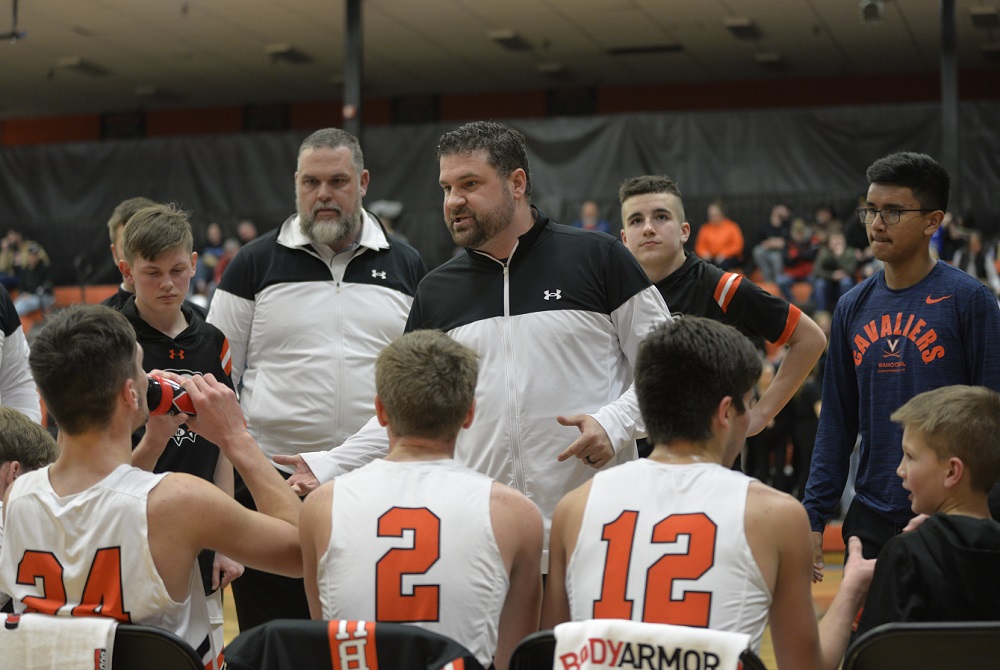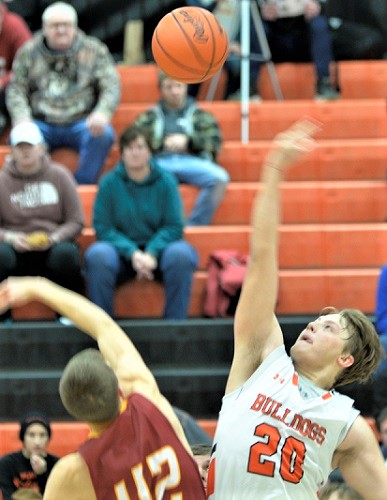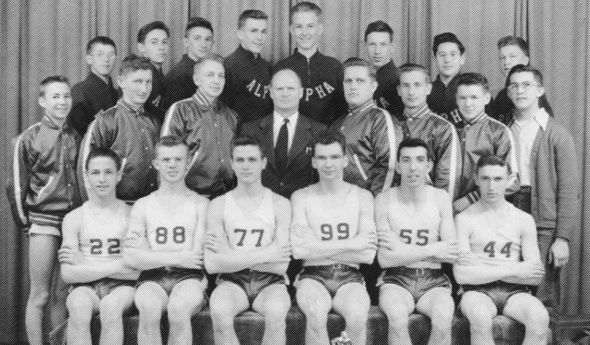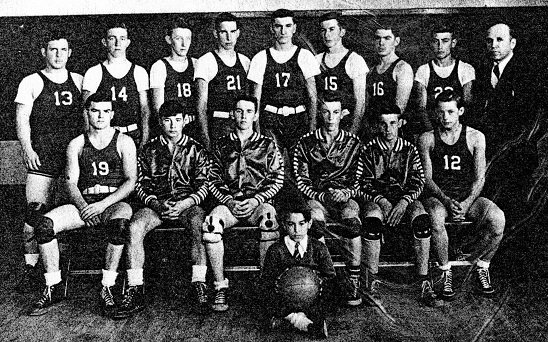
League Change Suiting Mesick Well as Talented Bulldogs Pursue Repeat
By
Tom Spencer
Special for MHSAA.com
January 21, 2022
Who let the dogs out?
 Who, who — let the Mesick Bulldogs — in?
Who, who — let the Mesick Bulldogs — in?
That’s the question West Michigan D League rivals may be asking.
And, it’s more like a what … with the answer being the league’s expansion to 10 schools for the 2018-19 school year that paved the way for Mesick to enter.
Until that point, the Bulldogs were part of the Northwest Conference. They won only three games total over their last two years in the Northwest while competing against schools like Buckley – which reached the Class D championship game in both of the Bulldogs’ final two years in their old league. Mesick’s girls – 8-2 this winter – were struggling too.
The last two years in the Northwest also were the first two for the boys varsity under head coach Kyle Duby. The move may have helped turn things around for Mesick, along with extensive offseason work and youth development efforts.
The Mesick boys won five games in 2018-19 and six in 2019-2020 before going 11-6 last year and capturing a share of the West Michigan D championship – Mesick’s first piece of a conference basketball championship in 39 years.
Today, they Bulldogs are 7-0 and in the driver’s seat in league play. They have wins over league opponents Big Rapids Crossroads, Bear Lake, Brethren, Mason County Eastern, Walkerville and Baldwin.
The boys, with an outright conference championship on their minds, will finish their first run through the league schedule against Marion next week. Marion came into the West Michigan D at the same time as Mesick.
“This year we knew we wanted to win the conference outright,” said Duby, who also serves as the school’s athletic director. “That’s one of our goals.
“We also have a goal to make a run – whatever that may look like – in the postseason,” he continued. “First and foremost, we wanted to win our conference outright.”
 Keeping their starters healthy and able to play has been a challenge for the Bulldogs, but scoring has not. Injuries and COVID-related absences have caused Duby to alter his starting lineup regularly as the Bulldogs are hitting 70 points-plus per game.
Keeping their starters healthy and able to play has been a challenge for the Bulldogs, but scoring has not. Injuries and COVID-related absences have caused Duby to alter his starting lineup regularly as the Bulldogs are hitting 70 points-plus per game.
Senior forward Conner Simmer is the team’s leading scorer, averaging 18. Another senior, Logan Wienclaw, chips in 12 from his center spot, while juniors Carter Simmer and Caleb Linna contribute 11.5 and 10 points per game, respectively.
“We have several kids who have worked hard for several years,” Duby said. “There is no one person you can shut down and expect to beat us.”
The Bulldogs, who also get almost eight points per game from junior Ashton Simerson, rack up 17 assists per games. Three-point shooting is also a strength. The Bulldogs got into the Michigan record books with 15 3-pointers on 32 tries in Thursday’s 73-45 win over Baldwin.
The Baldwin win helped erase memories of a big loss last year. Things are different as Mesick in nearing the halfway point of this home-and-home conference schedule. The Bulldogs have played the majority of their league games on the road and will be playing host a lot while enjoying their ride in the driver’s seat.
“Baldwin was the team that stopped us from an outright conference championship last year,” Duby said. “Winning in Baldwin and getting through the mental hurdle is exciting for us.”
High scoring has been a major contributor to the Bulldogs’ success to date, along with many of the current varsity having played together since middle school – the same time Duby took over the program.
Film study is another significant factor. Based on the review, the Bulldogs prepare to use a variety of presses and half court defenses from their repertoire.
“We have eight different defenses we can play depending on what the film said,” Duby pointed out. “We do what the films tells us.”
“Luckily I have had these boys since they were in sixth and seventh grade, and we played a lot of summer basketball,” he continued. “They are a high-IQ group.”
The road to success started years ago with a meeting Duby held with the parents of today’s Bulldogs.
“I knew the task of getting to this point was going to be a long one,” Duby said. “Right away, we started having them travel.
“We’d take a junior high, JV and varsity team and go down to Muskegon, Grand Rapids, Lansing … Flint and be downstate in summer about four weekends,” he continued. “We would take our whole program together and caravan and play basketball.”
Duby credits the fast start to his coaching staff, which includes Joe Lewis, Derek Linna, Nathan Hall and Jason McCree.
“My JV coach, Joe Lewis, has been with me since day one,” Duby said. “Over the years we’ve absorbed some dads to the staff.”
 Tom Spencer is a longtime MHSAA-registered basketball and soccer official, and former softball and baseball official, and he also has coached in the northern Lower Peninsula area. He previously has written for the Saginaw News, Bay County Sports Page and Midland Daily News. He can be reached at [email protected] with story ideas for Manistee, Wexford, Missaukee, Roscommon, Ogemaw, Iosco, Alcona, Oscoda, Crawford, Kalkaska, Grand Traverse, Benzie, Leelanau, Antrim, Otsego, Montmorency, Alpena, Presque Isle, Cheboygan, Charlevoix and Emmet counties.
Tom Spencer is a longtime MHSAA-registered basketball and soccer official, and former softball and baseball official, and he also has coached in the northern Lower Peninsula area. He previously has written for the Saginaw News, Bay County Sports Page and Midland Daily News. He can be reached at [email protected] with story ideas for Manistee, Wexford, Missaukee, Roscommon, Ogemaw, Iosco, Alcona, Oscoda, Crawford, Kalkaska, Grand Traverse, Benzie, Leelanau, Antrim, Otsego, Montmorency, Alpena, Presque Isle, Cheboygan, Charlevoix and Emmet counties.
PHOTOS (Top) Mesick boys basketball coach Kyle Duby addresses his team during a game this season. (Middle) Logan Wienclaw (20) goes up for a jump ball. (Photos by Daniel Cochrane.)

Before the Bridge: Class E & the UP
July 31, 2017
By Ron Pesch
MHSAA historian
This is the final part in a series on MHSAA tournament classification, past and present, that has been published over the last two weeks and originally ran in this spring's edition of MHSAA benchmarks.
The stories are worthy of the silver screen.
Long lost legends of lore, forgotten by most in the Lower Peninsula of the state of Michigan.
Absurd anecdotes of basketball played behind glass, and out-of-bounds lines painted on walls.
Tales of overlooked places like Trenary and Champion and Doelle and Watersmeet.
This is the story of MHSAA Class E basketball.
From 1932 to 1947, Michigan's Upper Peninsula did not compete in the state-sponsored basketball tournament. Instead, the U.P. held a separate basketball tournament, crowning champions in Classes B, C and D. In 1941, the state added a fifth classification – Class E, comprised of schools with a student body numbering 75 or fewer. A fourth bracket was added to the U.P. tourney.
Following the 1948 season, the Upper Peninsula returned to the state tournament. Winners of the traditional U.P. tourney were pronounced regional champions, and advanced to the state quarterfinals in Classes B, C and D. However, since there were no Class E schools with basketball teams in the Lower Peninsula, the winner of the U.P. tournament crown was proclaimed Class E state champion. This arrangement continued through the spring of the 1960 season.
Since they were the state's smallest high schools, the gymnasiums came in all shapes and sizes. Some sported a center circle that intersected with the top of the key. Basketball courts that doubled as a stage required netting to keep the kids and the ball on the court and away from the audience seated below.
Fred Boddy, a former coach at Champion, recalled his first visit to Doelle. Located in copper country near Houghton, the hosts were the proud owners of “the smallest” gym in U.P.
“I couldn't believe my eyes. ... Here on the second floor were windows and bleachers all around filled with fans. The gym, of course, was located on the first floor, but to get into the gym one had to go around to the back of the school to enter through the boiler room to the locker rooms, which opened onto the gym floor much like a dugout on a baseball field. The players sat on a bench under the wall and could look out and see the game in this manner. The free throw lines intersected and there were no out of bounds lines... the wall itself was ‘out of bounds.’ On the floor during the game were 10 players and two referees. There were no sounds as all the fans were up on the second floor, glassed in.
The cheerleaders tried valiantly to fire up the fans up on the second floor, but the teams couldn't hear in the quiet below. The score clock and statistician personnel were placed in a corner box high over the floor in one corner of the gym. They attained this lofty perch by a ladder that was removed from the trap door after all three were in position and the game could thus commence. The timer then tied a rope around his ankle. To send a sub into the game the coach would send the player along the wall heading for this rope. He would pull the rope causing the timer to look down through the trap door and at next opportunity would ring the buzzer and admit this substitute”
Regardless of the challenges presented by these cracker-box gyms, the fans loved their basketball. “The enthusiasm was just the same, if not bigger, than schools twice and 10 times their size,” noted longtime U.P. historian, Jay Soderberg.
Coach Joseph Miheve's 1941 Palmer squad captured the state's first Class E title with a 39-28 win over Hulbert at Ironwood. A graduate of Wakefield High School, Miheve had never played high school basketball, serving as the team's manager.
The 1942 tournament, scheduled for March 19-21, was postponed one week because the city of Marquette was more or less taken over “by nearly 1,000 selective service registrants from every county in the Upper Peninsula” who had another and more serious battle in mind – World War II.
Palmer, this time coached by Elvin Niemi, repeated in Class E with a 37-31 victory over Bergland. It was Palmer's 32nd consecutive victory.
No tournament was held in 1943 due to the involvement of the United States in the war. In the 1944 championship game, Cedarville jumped out to a 19-14 first quarter lead but was held to 24 points in the remaining periods and fell to Amasa, 51-43 at Ishpeming.
Trenary made its lone Class E finals appearance in 1945, losing to Bergland 49-39 at Ishpeming, while the Alpha Mastodons won their first U.P. title since 1934 with a 48-28 win over Champion in 1946. It was the second of five Class E titles for Alpha coach Gerhardt “Gary” Gollakner, one of the finest coaches to come out of the U.P. Gollakner had coached at Amasa two years earlier, and his Mastodons would earn three additional titles during the 19-year run of the Class E championships.
Bergland became the tourney's second two-time winner in 1947, with a 40-37 win over the Perkins Yellowjackets. Perkins made four trips to the Class E finals over the years, including an appearance in the final year of the tournament, but came away empty-handed each time.
The Nahma Arrows made their first appearance in the championship in 1951, losing to Michigamme. Led by coach Harold “Babe” Anderson, a cage star at Northern Michigan College during the early 1940s, the Arrows returned to the finals in 1952. Nahma finished the year with a 21-0 mark and a 64-44 win over Marenisco for the crown.
 The two teams met again in a finals rematch the following year. The scored was tied six times, while the lead changed hands seven times in this barnburner. With 15 seconds to play, Nahma led 64-60. Marenisco's Robert Prosser hit a jump shot, then teammate Bill Blodgett stole a pass and scored to knot the game at 64. With two seconds remaining, Nahma's Bernard Newhouse was fouled. Newhouse hit the first free throw, but missed on the second. Teammate Wendell Roddy tipped in the rebound, and the Arrows had their second title.
The two teams met again in a finals rematch the following year. The scored was tied six times, while the lead changed hands seven times in this barnburner. With 15 seconds to play, Nahma led 64-60. Marenisco's Robert Prosser hit a jump shot, then teammate Bill Blodgett stole a pass and scored to knot the game at 64. With two seconds remaining, Nahma's Bernard Newhouse was fouled. Newhouse hit the first free throw, but missed on the second. Teammate Wendell Roddy tipped in the rebound, and the Arrows had their second title.
Alpha returned to the championship circle in 1954 with a 52-48 win over Perkins.
The 1955 title game matched a pair of the finest teams in Class E history. Trout Creek, making its first championship appearance, downed Alpha 84-83 in another Class E thriller. Don Mackey led the winners with 39 points. Tony Hoholek paced Alpha with 31, while junior John Kocinski added 21-points for the Mastodons.
Kocinski, a four-year starter at Alpha, scored 1,782 points during his career, then an all-time U.P. record. He once scored 51 points against Amasa, and could have scored more according to teammate Walter “Slip” Ball. “He refused to shoot in the fourth quarter, and passed up one shot after another,” Ball said.
Without question, Trout Creek was one of the powerhouse squads during the final years of the tourney. The Anglers, coached by Bruce “Pinky” Warren, a former captain of Purdue's football team, made four trips to the finals during the last six years of the Class E tourney. The defending champions downed Alpha in the semifinals of the 1956 tournament, then knocked off Hermansville 86-68 in the finals to repeat. It was a year of celebration for fans of U.P. basketball, as four of the state's five champions – Stephenson (B), Crystal Falls (C), Chassell (D) and Trout Creek (E) – came from Michigan's northern peninsula.
Hermansville returned to the finals in the spring of 1957 and earned its second Class E title with a 77-51 win over Michigamme at Escanaba. Trout Creek downed Perkins 61-41 for their third crown in 1958.
The 1959 championship, hosted at Northern Michigan College's fieldhouse, was a showdown of the U.P.’s only undefeated squads, Trout Creek and Nahma. Trout Creek was riding a 24-game winning streak that dated back to the 1958 season. A scoring machine, Warren's Anglers averaged 81.7 points per contest. Nahma, 19-0 on the season, boasted the U.P.'s strongest defense. Still coached by “Babe” Anderson, the Arrows had allowed an average of 38.2 points per game. Led by senior Warren Groleau, Nahma had been last defeated by Trout Creek in the semifinals of the 1958 tourney.
Leading 25-15 at the intermission, Nahma matched Trout Creek point for point in the second half for a 55-45 victory.
Hermansville, behind Richard Polazzo's 29 points and Irwin Scholtz's 27, downed surprise finalist Perkins 72-50 in the 1960 finale, to end this chapter in MHSAA history.
Today, most of the former Class E high schools are long gone. Many have closed their doors and consolidated with other area schools. Amasa and Alpha merged with Crystal Falls to form Forest Park. Palmer is now part of the Negaunee school system. Bergland and Trout Creek joined forces with Class D Ewen to form Ewen-Trout Creek. Hermansville combined with Powers to form North Central, to name but a few. A few remain: Dollar Bay, Marenisco (now Wakefield-Marenisco) and Watersmeet, and their enrollments are much the same as in the glory days of the state's fifth classification.
Author’s note: Special thanks to Jay Soderberg and Roger Finlan, who assisted in gathering statistics and quotes used in this article. Thanks also to Dick Kishpaugh, Bob Whitens, Walter “Slip” Ball, Dennis Grall, Fred Boddy, Bruce Warren, Gene Maki, Harold “Babe” Anderson and the various personnel at U.P. high schools for their contributions to this story.
PHOTOS: (Top) The Alpha boys basketball team won the 1950 Class E title by nearly doubling up Michigamme, 52-28. (Middle) Hermansville claimed the 1948 title with a 58-38 win over Rockland.

